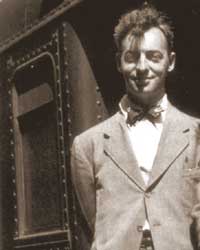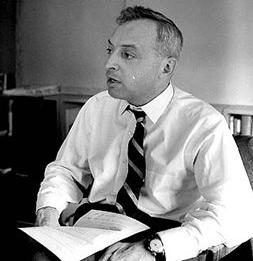Saul Bellow

The Life of Saul Bellow
 Though
he was born in the Montreal suburb of Lachine, Quebec in 1915, Saul Bellow
was raised in Chicago. The son of impoverished Russian immigrants, Bellow
attended the University of Chicago, and received a bachelor’s degree
in sociology and anthropology from Northwestern University. He did graduate
work at the University of Wisconsin before serving as a Merchant Marine during
World War II. His varied background of Yiddish, English and French is integrated
into his writing style, and has contributed to his prominence as an author
in the American-Jewish community. This recognition has extended beyond cultural
boundaries, as he has received recognition and numerous awards in the literary
world. His many honors include the National Book Award for fiction, International
Literary Prize, and the Pulitzer Prize, as well as the Nobel Prize for literature
in 1976.
Though
he was born in the Montreal suburb of Lachine, Quebec in 1915, Saul Bellow
was raised in Chicago. The son of impoverished Russian immigrants, Bellow
attended the University of Chicago, and received a bachelor’s degree
in sociology and anthropology from Northwestern University. He did graduate
work at the University of Wisconsin before serving as a Merchant Marine during
World War II. His varied background of Yiddish, English and French is integrated
into his writing style, and has contributed to his prominence as an author
in the American-Jewish community. This recognition has extended beyond cultural
boundaries, as he has received recognition and numerous awards in the literary
world. His many honors include the National Book Award for fiction, International
Literary Prize, and the Pulitzer Prize, as well as the Nobel Prize for literature
in 1976.
Bellow’s career as an author began with the publication of the novel
Dangling Man (1944) and was followed by The Victim (1947).
Both of these works were nationally well received by critics, and reflected
of his life, focusing on the life of a Jewish artist struggling to survive
in a strongly anti-Semetic post World War II society. Following these early
successes, Bellow received a Guggenheim Fellowship, which allowed him to travel,
and write his third novel, The Adventures of Augie March
(1953), for which he was awarded his first National Book Award for fiction
in 1954. After this, Bellow was to receive this honor twice more, for Herzog
(1964) and Mr. Sammler’s Planet (1970). Herzog also led to
Bellow paving the way for Americans, as the first to win the International
Literary Prize. He has also been recognized in France with the Croix de Chevalier
des Arts et Lettres, and by the Jewish community with the B'nai B'rith Jewish
Heritage Award, for excellence in Jewish literature.
In addition to novels, Bellow has also written plays, non-fiction and short stories. He has taught at Bard College, Princeton University, and the University of Minnesota. Bellow currently serves on the Committee of Social Thought at his alma mater, the University of Chicago. He is married to Janis Freedman Bellow, his fifth wife, with whom he has a young daughter.
The Writing of Saul Bellow
 The
writing style of Saul Bellow is unique in its descriptive nature, which is
full of blatant cultural and historical references. He uses his settings to
move his story along, and to help portray characters, ideas, and emotions.
Raised during the Great Depression, the struggles incurred by less fortunate
Americans come out in Bellow’s writing. His bleak descriptions of buildings
and dismal portrayals of the Chicago streets emphasize hard times had both
by characters in his novels, as well as countless Americans. The aspect of
Bellow’s work that makes him stand out among writers is not that he
wrote about the Depression. What makes Bellow exceptional is his ability to
describe what the Depression felt like, what it looked like to the average
struggling American. The sense that the wind cut through his thin jacket a
bit harder, the idea that the bread he ate was a bit staler, the concept of
showing the Depression, not just telling it was what makes Bellow’s
writing distinctive. Besides descriptive writing, Bellow makes a point to
incorporate cultural, philosophical, historical, and literary references into
his works. This aspect of his work demonstrates his education in a variety
of disciplines, and also gives an added element of depth to his writing.
The
writing style of Saul Bellow is unique in its descriptive nature, which is
full of blatant cultural and historical references. He uses his settings to
move his story along, and to help portray characters, ideas, and emotions.
Raised during the Great Depression, the struggles incurred by less fortunate
Americans come out in Bellow’s writing. His bleak descriptions of buildings
and dismal portrayals of the Chicago streets emphasize hard times had both
by characters in his novels, as well as countless Americans. The aspect of
Bellow’s work that makes him stand out among writers is not that he
wrote about the Depression. What makes Bellow exceptional is his ability to
describe what the Depression felt like, what it looked like to the average
struggling American. The sense that the wind cut through his thin jacket a
bit harder, the idea that the bread he ate was a bit staler, the concept of
showing the Depression, not just telling it was what makes Bellow’s
writing distinctive. Besides descriptive writing, Bellow makes a point to
incorporate cultural, philosophical, historical, and literary references into
his works. This aspect of his work demonstrates his education in a variety
of disciplines, and also gives an added element of depth to his writing.
In class we discussed Collected Stories (2002), a compilation of short stories originally published individually or in conjunction with other works. These short stories offer introspection on Bellow’s writing style, and emphasize the focus of his interests: the Depression. The following passage, taken from "Looking For Mr. Green," shows Bellow’s trait of powerful language as he describes Chicago:
Rebuilt after the Great Fire, this part of the city was, not fifty years later, in ruins again, factories boarded up, buildings deserted or fallen, gaps of prairie between. But it wasn’t desolation that made you feel, but rather a faltering of organization that set free a huge energy, an escaped, unattached, unregulated power from the giant raw place.
Another characteristic of Bellow’s writing are his characters. His protagonists are atypical, yet extraordinary, and portrayed with tremendous detail. Both major and minor personalities are given attention, and discussed in a manner that supports the theme of the story. This excerpt, taken from "A Silver Dish" describes two unnamed men, and emphasizes the setting while giving the reader an idea of the characters:
The two coal trimmers stood up at Devond Avenue. One of them wore a woman’s coat. Men wore women’s clothing in those years, and women ment’s, when there was no choice. The fur collar was spiky with the wet, and sprinkled with soot. Heavy, they dragged their shovels and got off in at the front.
Due to the descriptive nature of his work and his distinctive use of setting, characters, and style to paint a portrait for the readers, Saul Bellow was awarded the 1976 Nobel Prize in Literature "for the human understanding and subtle analysis of contemporary culture that are combined in his work."
More Bellow Resources
Additional information on Saul Bellow, including Nobel speeches, lectures, and links can be found here.